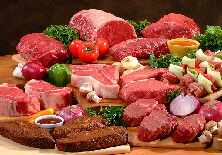The Micro Abattoir - History
Ecological Concerns
Noise:
The corral system was designed in such a way to reduce animal stress and minimize noise. The animals are rendered unconscious before slaughter using a captive bolt stunner which creates minimal noise.
Odor:
Experience with similar sized slaughter operations has shown that they do not cause odors. The slaughter establishment at Olds College is located right beside the student residence. Local students who lived at the residence have reported that there was never any smell. Solid waste will be stored in a cooler until it is delivered to the landfill. Liquid waste will flow into a septic system specifically engineered to meet the Ministry of Environment requirements. No value added activities like tanning or rendering which could produce odors are planned for this site.
Benefits of a Local Abattoir
The production of locally produced meat is more cost effective and less stressful on the animals.
The consumer has access to locally produced meats from an identified source. The retailer has the option of selling locally produced meat products. The restaurant industry is able to feature locally produced foods. Individual producers are able to create niche markets for their products such as “Grass Fed”, “Hormone Free” or “Organic”.
Immediate Economic Benefits we can expect are: Employment opportunities in the abattoir, new livestock production units starting, Cut and Wrap facilities increasing business, value added costs will stay in the Valley, tourism value of local food.
Future possible Economic Benefits: Locally produced pet food, viability of a Tannery and related leather industry.
Neighborhood Concerns:
On May 3, 2013 we received zoning approval to construct an abattoir on our land at the Crossroads (Lot C, District Lot 9561) with the following restrictions:
1. Shall not have building exceeding a total gross floor area of 160 m2 (1700 sq.ft)
2. Shall not occupy more than 1 ha of the parcel area
3. Shall not have more than 10 animal units stored outside at any time.
4. Shall not have any building sited less than 280 m (918 ft.) from Highway 93/95
It will never be more than a small Abattoir!
Cost and Funding:
Sources of funding were: $ % of project
Humane Slaughter Program 7,000.00 1.11 %
Fundraising Auction 7,200.00 1.14 %
Regional District of East Kootenay 8,000.00 1.27 %
In Kind Donations 15,600.00 2.47 %
Southern Interior Development Initiative 25,000.00 3.96 %
Columbia Basin Trust 70,000.00 11.10 %
Windermere District Farmers’ Institute 125,279.22 19.11 %
Private Cash Donations 373,358.90 59.13 %
Total Cost 631,438.12

Links to Reports:
Background
In the past, livestock were regularly processed and sold in the valley. The new Meat Inspection Regulations which were enacted in 2004 require that abattoirs have to be licensed to produce meat for sale for human consumption. The nearest licensed abattoir is 133 km from Invermere which means farmers have to transport animals a significant distance and then make a second trip to retrieve the meat. This is stressful for the animals and costly for farmers.
As a result it became more difficult for the public to purchase locally produced meat and the number of livestock produced for local consumption has decreased. Many of the small producers went out of business and the number of livestock raised in the Valley has decreased significantly. Therefore the Windermere District Farmers’ Institute wanted to construct a small abattoir where our livestock can be custom slaughtered, inspected and sold.
The site chosen is on Lot C, District Lot 9561, Kootenay District, Plan 2891. The location is just south of the Invermere Crossroads on the West Side of Highway 93/95. The main reason we have chosen this location is because the Windermere District Farmers’ Institute owns the land. The site is suitable because it is centrally located to the service area and has easy highway access. It is surrounded on all sides by the property owned by the Windermere District Farmers’ Institute and is well set back from the highway.

Created by: Brisco Software
Timeline:
2004 – new regulations re sale of meat to consumers
2006 – WDFI forms committee to investigate building a provincially inspected abattoir
2010 – MTAP (Meat Transition Assistance Program) funding of $150,000 approved with a deadline for construction of Dec. 30, 2012. This funding was lost as we needed to receive zoning approval before we could build.
2010 – June - Feasibility Study completed
2013 – May - Zoning approval received
2013 – May - Business Plan completed
2015 – Oct. – Grant Kelly signed contract for lease of abattoir
2015 – Nov. – Funding Contract signed with Hedi Trescher
2016 – May – Construction started – General Contractor NCM Construction – Chris Wiegert of Invermere
2017 –March - Open for business.
Windermere District Farmers’ Institute

